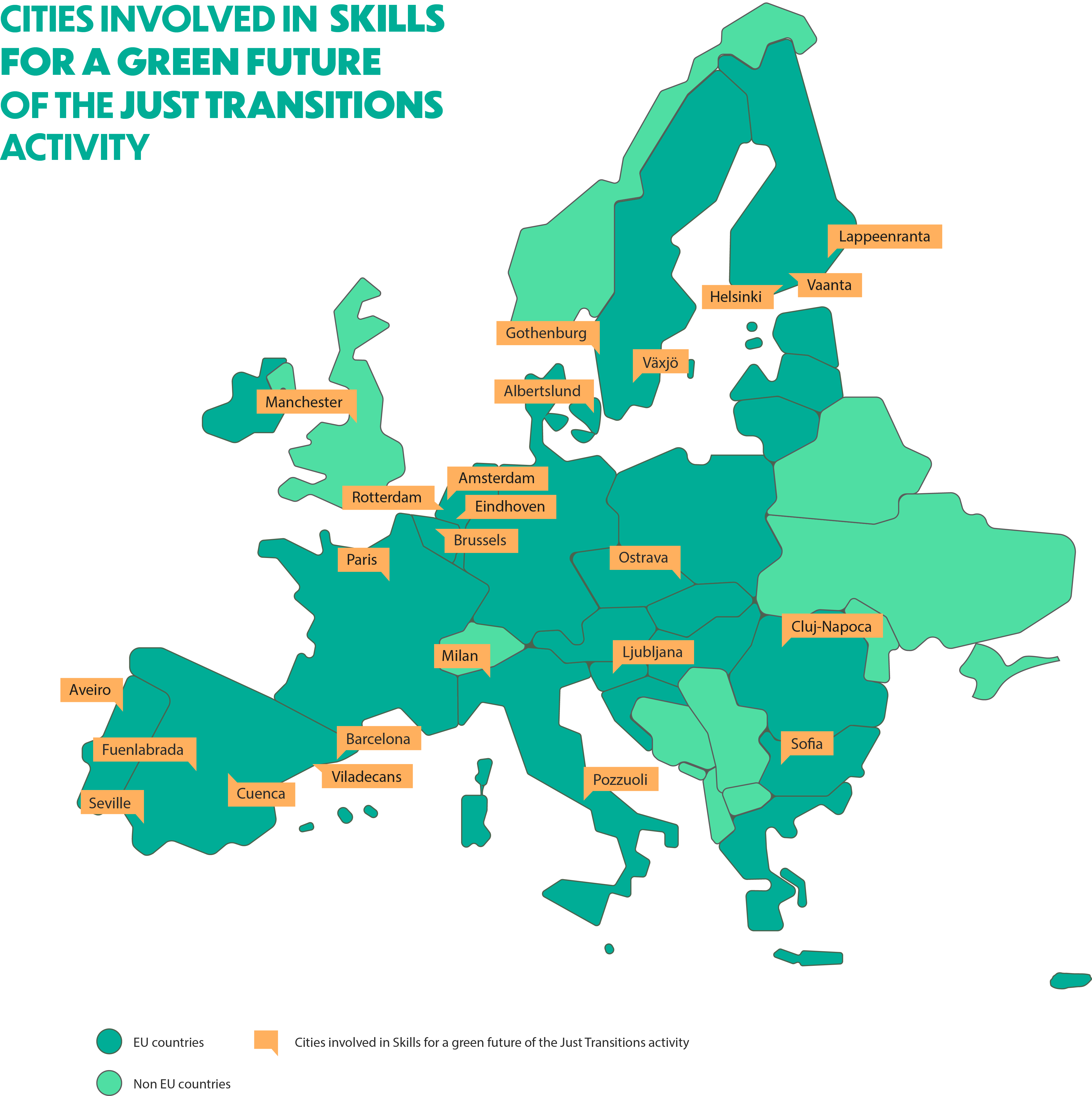This report is one of a series of final written outputs focused on the contribution UIA cities are making to jobs, skills, business, and Just Transitions. It is the result of a process that began with a high-level scan of all 86 UIA projects which identified 24 highly relevant city cases . Their challenges, interventions and experiences were then explored through a survey conducted in autumn 2021 followed by a series of city hearings through November and December 2021.

1.Introduction
“The cumulative scientific evidence is unequivocal: Climate change is a threat to human well-being and planetary health. Any further delay in concerted anticipatory global action on adaptation and mitigation will miss a brief and rapidly closing window of opportunity to secure a liveable and sustainable future for all.”[1]
As the latest Intergovernmental Panel on Climate Change (IPPC) report makes clear, our planet is on fire. The luxury of debating time has passed, and the mounting evidence makes it clear that the time to talk has been replaced by the time to act. In Europe, where most citizens live in urban areas, cities are in the front line of designing and implementing climate change adaptation and mitigation actions.
As Europe’s urban laboratory, the Urban Innovative Actions Initiative (UIA) supports cities to develop and implement innovative solutions to the most pressing urban problems. Many of these are focused on topics[2] directly related to the climate emergency within the framework of sustainable urban development, such as Climate Adaptation, Energy Transition, Air Quality and Jobs and Skills.
This report is one of a series of final written outputs focused on the contribution UIA cities are making to jobs, skills, business, and Just Transitions. It is the result of a process that began with a high-level scan of all 86 UIA projects which identified 24 highly relevant city cases[3]. Their challenges, interventions and experiences were then explored through a survey conducted in autumn 2021 followed by a series of city hearings through November and December 2021[4].
A series of ‘key witness’ organisations was also undertaken. These have included agencies directly focused on the issue of jobs and skills as well as others with a wider remit touching upon it. The UIA Permanent Secretariat assembled a Sounding Board of relevant organisations to help guide the overall process and their comments have also been hugely helpful.
[1] IPCC, Climate Change 2022, Impacts, adaptation and Vulnerability (February 2022)
[2] The 14 UIA Topics closely mirror the themes of the Urban Agenda for the EU Partnerships
[3] It is important to note that none of the UIA projects had a specific focus on Just Transitions. Instead, they were grouped under the 14 UIA topics, which include Climate Adaptation, Energy Transition, Air Quality and Jobs and Skills.
[4] The list of UIA cities, Sounding Board members and key witnesses that have been part of the process are available in the Appendix section of the online report.

2. The context for cities, jobs, and Just Transitions
For many years, fear of the economic impact of a climate neutral economy inhibited progress towards that goal, particularly amongst industrially advanced nations. As far back as 1992, the United States refused to ratify the breakthrough Kyoto Protocol[1] over concerns for its impact on its economy, with its strong established links to fossil fuels. The USA was not the only country with these misgivings, because climate change has clearly shown the deep links between the environmental emergency and the established social and economic order.
The scale of that emergency has been augmented by governmental deliberation. Consequently, the room for manoeuvre has diminished and the need for deep structural change within our economies has become more pressing. As a result, the scale and complexity of the transition ahead – within a much-compressed timeframe – are more daunting.
The effects of the transition will be distributed unevenly. Those regional economies more reliant on traditional, energy intensive heavy industries will face acute challenges. As our Inception Report noted, the European Commission (EC 2018) forecasts three such sectors to completely decline and another four to be totally transformed[2]. These industry sectors account for 338,000 jobs in the EU, heavily clustered in specific regions.
At the same time, the twin megatrends of green and digital are expected to continue the reduction of lower-skilled occupations[3]. The rapid speed of labour market change will require frequent reskilling to remain employable. Yet recent data[4] shows that only around 20% of adults with low skills participates in learning and training, compared to 37% for the medium skilled and 58% for the highly skilled. Failure to encourage higher take up rates in training is likely to exacerbate the existing skills mismatch[5], and to widen inequality rates, particularly in urban areas where these are already most pronounced[6].
However, it is important to recognise that this is not a doomsday scenario. Various respected sources have underlined the potential of the shift to climate neutrality to generate jobs and businesses. For example, Eurofound forecast that full implementation of the Paris Agreement by 2030 could stimulate a 1.1% growth in E.U. GDP alongside a 0.5% boost in employment across the EU. The latest EU data (European Commission, 2019) shows that low carbon sectors employ more than 70% of the EU workforce and that these are the fastest growth sectors.
A narrow definition of the ‘Green Economy’ indicates a relatively small workforce of around 4.5 million workers. However, this is boosted by a wider embrace of low carbon industries, whilst it is clear from this work that a wide range of new industry sectors are coming through, for example related to the application of nature-based solutions, carbon-neutral mobility innovations and the development of sustainable food systems.
[1] The Kyoto Protocol was produced at the same time as the UNFCCC was established to oversee the transition to climate neutrality
[2] Coal and lignite mining, crude oil and gas extraction and mining support services are the three expected to disappear. Chemical manufacturing, non-metallic mineral manufacturing, metal manufacture and the automotive sector are the four expected to completely transform
[3] OECD, Putting faces on the jobs at risk of automisation, 2018
[4] OECD, Future Proofing Adult learning systems in cities and regions, 2022
[5] CEDEFOP, Insights into skill shortages and skill mismatch, 2018
[6] Data from JRC Cities report

3. The policy framework for cities
The European Green Deal (EGD) sets the overarching policy response to the Climate Emergency. It will provide the finance and framework to design and implement the interventions required to transform the EU into the world’s first climate neutral bloc by 2050. The intention is to decouple economic growth from resource use, leaving no person or place behind.
The EGD stresses the need for a just and inclusive process towards climate neutrality. It specifically acknowledges that:
“The most vulnerable (people) are the most exposed to the harmful effects of climate change and environmental degradation. At the same time, managing the transitions will lead to significant structural changes in business models, skill requirements and relative prices. Citizens, depending on their social and geographic circumstances, will be affected in different ways” (European Commission, 2019).”
The commitment to social justice within the EGD reflects the EU’s adherence to the United Nations Sustainable Development Goals (SDGs) and its own target to lift 15 million of its citizens out of poverty by 2030[1]. This alignment of social and environmental justice is supported by a wave of ancillary funds which include the Just Transition Fund and the Climate Social Action Fund. These significant resources are amplified by the shared commitment of the European Investment Bank (EIB) which has leant its significant weight behind this agenda through its increased focus on the shift to climate neutrality[2].
However, although the resources are in place, the success of these macro measures will rely heavily on the extent to which they are effectively mobilised at the local level[3]. It is well understood that cities, which consume 78% of global energy and generate over 60% of its Greenhouse Gas emissions, are instrumental in delivering the EU’s climate goals. As cities are the cause of so many of these challenges, so too must they be part of the solution.
The EU’s robust and well-established model of sustainable urban development (SUD) provides a suitable framework for this to happen, particularly as it sits at the heart of EU Cohesion Policy. This supports the development of long-term strategies built around the integrated approach. This concept includes six dimensions that are prerequisites for the realisation of Just Transitions in urban areas. One of them relates to the territorial focus of the strategy, highly relevant when policy areas like mobility, energy infrastructure and labour markets often require a functional urban area (FUA) perspective.
Another is the governance dimension which stresses the need for multi-level government mechanisms, a multi-stakeholder approach and the partnership principle. City authorities cannot achieve the goal of climate neutrality alone. Equally, achieving Just Transitions will require active collaboration at all levels of government, effective partnership working around a quadruple helix model[4] and mechanisms to engage and mobilise citizens. The complexity of the Just Transitions challenge also needs government to work across departmental silos, another keystone of the integrated approach to SUD.
Although there are many concrete examples of these SUD principles in action[5], cities will have to further raise their game to achieve Just Transitions. The increased emphasis on capacity building[6] within the new Cohesion Policy will bring additional support tools through the establishment of the European Urban Initiative supporting an increase in SUD activity. Embedding UIA within the EUI should also help address another key consideration: the replication and scaling of effective innovations.
[1] Set out in the European Pillar of Social Rights
[2] The EIB’s 2021 Investment Report contains a key chapter on the transition to a smart green economy
[3] Eurocities, The European Green Deal: delivering results for citizens with Europe’s cities, 2020
DG GROW, The Intelligent Cities Challenge, 2021
[4] https://en.wikipedia.org/wiki/Quadruple_and_quintuple_innovation_helix_framework
[5] JRC Strat Board
[6] The capacity building component of EUI will add the firepower of Innovative Actions to established mechanisms which include the Urban Development Network and URBACT
Text
There is evidence that some of the UIA city projects identified in this study have influenced mainstream Cohesion Policy investments in the 2014-2020 programming period. For example, the Rotterdam BRIDGE project informed the development of the city’s Work Learning Agreements as well as shaping a number of social return initiatives, such as the Starter Motor projects, drawing upon ERDF funds. These funds have also supported the sustained scaling of BRIDGE beyond the UIA funding period.
Looking ahead, other Managing Authorities that have been less hand-on with UIA projects are exploring ways to encourage the mainstreaming and replication of results in the next programming period. Finland, which had five successful UIA projects is a good example of this. For the new programming period the Managing Authority has established an innovation framework for the largest Finnish cities to encourage collaboration, scaling and the transfer of effective interventions.
There is evidence that some of the UIA city projects identified in this study have influenced mainstream Cohesion Policy investments in the 2014-2020 programming period. For example, the Rotterdam BRIDGE project informed the development of the city’s Work Learning Agreements as well as shaping a number of social return initiatives, such as the Starter Motor projects, drawing upon ERDF funds. These funds have also supported the sustained scaling of BRIDGE beyond the UIA funding period.
Looking ahead, other Managing Authorities that have been less hand-on with UIA projects are exploring ways to encourage the mainstreaming and replication of results in the next programming period. Finland, which had five successful UIA projects is a good example of this. For the new programming period the Managing Authority has established an innovation framework for the largest Finnish cities to encourage collaboration, scaling and the transfer of effective interventions.
4. Cities, Jobs, and Just Transitions: UIA cities’ perspectives
The following chapters investigate the detail of UIA city activity relating to skills forecasting, supporting new green sectors and re/skilling for the Green Economy. Prior to that, findings from the UIA city survey[1] provide a helpful insight into their operational context and perspectives around Just Transitions.
[1] The survey, undertaken in autumn 2021, contains 20 responses from UIA cities identified as being active around Green jobs and skills
It is encouraging to see that all these cities displayed a high degree of confidence that they would achieve climate neutrality without leaving any person or place behind. The figure below illustrates the range of responses. Most cities were reluctant to award themselves a 5, acknowledging that the scale of the task is significant, with many unknowns ahead. Several specific factors were mentioned as being vitally important to a successful outcome.
One of these was political leadership, with the risk that administrative changes and any reduced top-level commitment would have an adverse impact. Another was finance, and in particular the ability to mobilise the required levels of investment from the private sector to complement public funds. A third was citizen engagement and buy in. A compelling narrative is required relating to Just Transitions, combined with meaningful participative processes and effective interventions, particularly around the most marginalised in the labour market.

Cities cited five recurring barriers they face. The five most frequently cited barriers, were, in order, as follows:
1. The mobilisation of citizens
Reduced resilience after the pandemic, high energy prices and concerns about unemployment were all cited as reasons why many citizens are anxious and afraid of the transition to climate neutrality. However, the headline goal cannot be achieved without strong public support. Mobilising this will need a compelling narrative and a shift in mindsets. For example, one respondent noted the need for “having sufficient demand for sustainable products and services and attracting people to the ‘new’ jobs (bike mechanic not as cool as a car mechanic for instance).”
2. Getting businesses on board
Engaging the private sector – and in particular those small and medium businesses that comprise most of the economy – was also identified as an ongoing challenge. Characterised by limited financial resources and capacity, particularly in key sectors heavily affected by the pandemic, for many SMEs’ the priority is short term survival. Lacking the Human Resources (HR) capability of corporates, adapting business behaviours and supporting the skills revolution presents a major challenge for them. Getting them on board requires a culture shift from reactively responding to regulatory changes to adopting an active participatory role in wider change. This will not happen without publicly funded support and/or incentives of various types.
3. Low levels of municipal capacity
Amongst local civil servants, low levels of awareness and skills gaps were routinely identified as major barriers to local authorities’ ability to support green skills and business development. We have already noted the requirement for cross-departmental collaboration combined with effective multi-stakeholder approaches. This must be underpinned by a basic knowledge of the implications of the shift to climate neutrality, and how this will affect all policy areas. Some cities are taking proactive steps to provide tailored support to City Hall staff on these issues, but there is a need for this on a systemic level.
4. Limitations in the local low energy infrastructure
People working in well-functioning economies in climate neutral cities will require affordable carbon free mobility networks. They will also need energy efficient buildings that utilise nature-based solutions to combat temperature extremes. Underpinning this will be high speed digital infrastructure, reducing the need to travel and supporting business efficiency. Although the survey respondents acknowledged the progress under way, this is by no means universal, and it also takes time.
5. Local skills mismatches
The survey responses confirmed the extent of skills mismatches within cities and the risk that these widen as the economy transitions. One city noted that one third of their employees have only primary level education whilst another noted the improvement of green skills provision, but a lack of demand from the private sector: “Although the government and education sector are improving greener skills, it is strictly necessary that companies start demanding those skills. Otherwise, we will have many unemployed people trained in green skills.” Clearly, this requires a carefully co-ordinated approach and an efficient local skills system informed by reliable foresighting, ongoing dialogue between key actors and informed strategic investment.

5. Who is most at risk of being left behind?
70% of our UIA survey respondents thought that specific groups in their city were more at risk of being left behind. The following five groups were identified in this category, in order of frequency:
1. Vulnerable people already marginalised in the labour market
In many cities, the pandemic has highlighted the relatively large numbers of people with a precarious connection to the labour market. In more normal times they are less visible, working in the platform economy, in the grey economy or in sectors like catering and taxi driving where they are off the radar of the authorities. This category also includes people, many of them young, working freelance in the creative and cultural industry sector. When their employment dried up during COVID they were often ineligible for structured financial support and driven to seek hardship assistance from public authorities.
For example, research in Rotterdam (NL) showed that 15,000 of the city’s 43,000 self-employed sought temporary income support during the COVID period. The same research into the city’s most vulnerable groups concluded that they are often low-educated and relying on various welfare sources. Another of our sample cities, Cluj-Napoca, identifies young people working freelance in creative industry sector as being highly vulnerable, as well as the local Roma population.
This is not then a homogenous group. But what they share is a tenuous link to the formal labour market and insufficient knowledge and resources to invest in their own future skills development.
2. The low-skilled
We have already noted that the twin drivers of green and digital, including the ongoing process of automation, will continue the erosion of low-skilled jobs in the EU labour market. In addition, there has been reference to the recent OECD research showing that the lower someone’s skill levels, the less likely they are to participate in training. Consequently, as the labour market is being transformed at a rapid rate, it is not surprising to see the low skilled identified as an at-risk group by our city respondents.
3. Women, older people and youth
Older people are at risk of being left behind unless they ensure that their knowledge and skills are updated in line with changes taking place in the economy. At the other end of the age spectrum, youth unemployment rates are higher than those for adults in most Member States with the risk of scarring for those with a prolonged experience of being NEET . Young people must also have a good awareness of the fast-changing labour market, to make the right career choices while in the education system.
On the surface, it might seem that the replacement of traditional heavy industries with cleaner, higher tech alternatives should work in favour of women in the labour market. However, as the International Labour Organization (ILO) has pointed out, without active policy interventions, the energy transition is likely to create more jobs usually assigned to men than to women (ILO 2019 ). For example, in the renewable energy sector, where the number of jobs could increase from 10.3 million in 2017 to nearly 29 million in 2050, women only represent 32% of employees (IRENA 2019) . More women also tend to work in precarious jobs which are lower paid and so have less resilience to economic shocks and in the transition to net zero.
4. Micro-business employees and the self-employed
We have already noted that those workers in the platform economy, often technically self-employed, are highly vulnerable to economic fluctuations and therefore at risk of being left behind in the green transition. However even those who are more traditionally self-employed - as well as micro businesses – are identified by our UIA cities as being at risk.
This stems largely from the fact that they have limited capacity and resources to develop long-term strategies or to invest in skills training unless it is directly related to their day-to-day business or can provide short term financial returns. City authorities and business support agencies routinely report on the challenges faced in engaging with this micro business sector, which accounts for a relatively large proportion of the overall business population in many cities. Hence it has been red flagged as a section of the community to be mindful of.
5. Workers in energy intensive and high carbon emitting industries
The predicted loss of over almost 400,000 jobs in the most energy intensive industry sectors has already been noted, as these sectors wind down in the coming years. Although they will be replaced by new supply chains in the renewable, circular, and low carbon economy, there is no guarantee that the transition across sectors will be smooth.
Evidence from other transition experiences underlines the importance of collaborative regional approaches to support vulnerable workers in these experiences. Locally focused governance models, with the active participation of employer and trade unions, as well as local government, which can create high levels of trust, have been especially effective .
The importance of collaboration is a recurring theme in the Just Transitions arena. The importance of multi-level governance models has also been underlined, as one of the pillars of the SUD model. The survey asked our UIA cities to assess the level of effectiveness of their own relationship with other levels of government, with the results illustrated in the figure below.

From the detailed responses, it is encouraging to see that in some cases, Cohesion Policy and related EU funds have been instrumental in strengthening the vertical connections between the layers of government.
“[In Italy] The National Resilience and Recovery Plan (PNRR) fostered the vertical governance and cooperation, pushing cities’ representatives and national government to work together on the new national development plan. The PNRR is part of the Next Generation EU Programme that the EU negotiated in response to the pandemic crisis.”
In other cases, there is a clear demarcation of competencies, but an established working relationship between the different levels of government:
“On employment and economic development issues, the city always works with the region and the state, which holds the competencies.”
Elsewhere, cases cities are working hard to create new spaces for collaboration around this relatively new, pressing topic, for them.
“The concept is recognised and action begun to tackle it, but as yet this is not coordinated across regions and national level.”
A relatively high proportion – over one third – are critical of the current collaborative arrangements. There is clearly room for improvement here, and amongst the associated comments were these points:
“Some regional policies designed to support transition are blocked by federal policies.”
“The majority of projects related to this kind of transition tend to be centralised and not organised through a proper local clarification.”
UIA cities’ activities promoting green skills, jobs, and business
The following chapters explore the innovative activity being undertaken by UIA city projects relating to our three sub themes:
- Skills forecasting for the green economy
- Supporting emerging green sectors
- Skilling and reskilling
These chapters draw upon the research and fieldwork undertaken with our sample of UIA cities, including the City Hearings held in late 2021.

About this resource
The Urban Innovative Actions (UIA) is a European Union initiative that provided funding to urban areas across Europe to test new and unproven solutions to urban challenges. The initiative had a total ERDF budget of €372 million for 2014-2020.
Similar content




